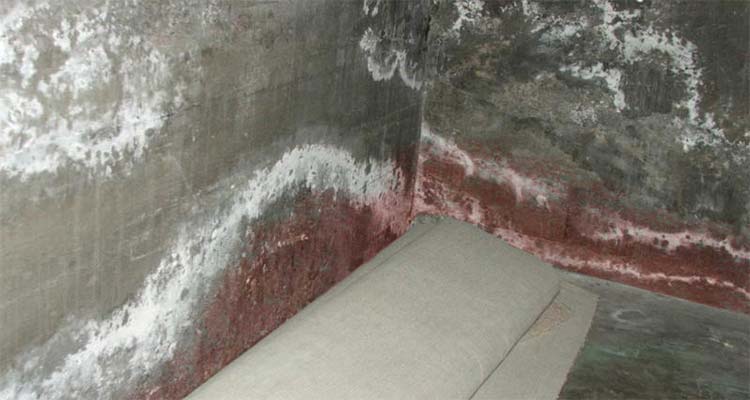What Are Those White Basement Wall Stains?

Share this Post
If you have an unfinished basement with bare concrete or block walls, you might notice white basement wall stains that happen over time. You will gradually see an efflorescence, with white and sometimes red stains on the walls. This visual warning is chemistry at work.
Table of Contents
The Origin of White Basement Wall Stains
During the construction of your home, a waterproof barrier was placed on the outside of your basement walls before the backfill was pushed in to cover them. That backfill is loose, disturbed soil that contains rocks and will never have the compact density of the undisturbed ground surrounding it. As a result, water tends to fill that area first after every rainstorm.
The backfill soil and its rocks will move with every rainstorm. Eventually, the exterior waterproof material will wear away from the movement allowing groundwater to saturate your basement walls. Rainfall in the Northeast averages about 28 to 62 inches a year, so wear and tear of that waterproofing will happen sooner than later.
Unfortunately, sometimes a home construction company may not apply waterproofing before filling the outside space around the basement with backfill. That means the discoloration of white and red could appear not long after the construction of your home. There is much shoddy craftsmanship, and many of our American Dry inspectors have spotted structures that would never pass a building code inspection.
The Chemically Unfolding Properties of Efflorescence
The soil in the Northeast, by nature, is acidic. The absorption of water and acidic silt (fine dirt carried by water) can lead to the breakdown of lime. Lime is part of the chemical makeup of concrete and acts as the bonding glue in concrete mixtures.
The white powdery staining inside the basement walls is evidence that the breakdown process is taking place. The acidic soil (acid) and lime (glue for concrete) are opposites. They neutralize each other upon contact, and the lime loses its ability to keep the concrete together.
Your house will not crumble instantaneously, but it will form wall cracks, shift the house, so doors and windows will not close properly, and possibly lift the roofline exposing your home overhead.
How to Stop The Destructive Process of Efflorescence?
American Dry Basement Systems can help you regain your home’s structural integrity before it is too late. We use our propriety SuperSlurry (for walls) and SuperCrete (for floors) to help reverse the chemical breakdown of concrete. Don’t hesitate to contact us for a free, no-obligation inspection and quote. We will not recommend any of our services unless it is entirely necessary.
Learn More! Get more information about safeguarding your basement from water seepage by reading our other post: WHY DO MY SHEETROCK WALLS HAVE CRACKS?
Schedule a free, no-obligation inspection and quote at no cost.